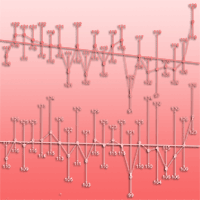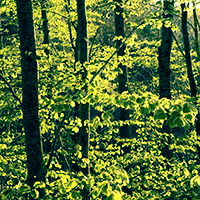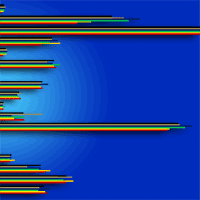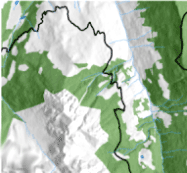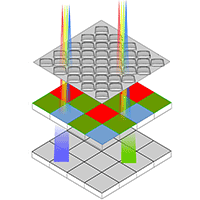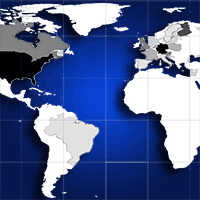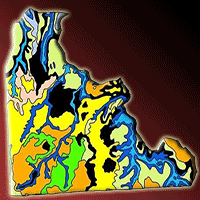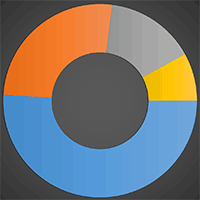This study focused on trends and driving forces of the leaf unfolding (LU) onset of oak and beech forests in the Slovak Carpathians along elevational gradients in the period 2000-2021. Particular attention was paid to improving the modelling of the LU onset using the MOD/MYD09 Moderate Resolution Imaging Spectroradiometer (MODIS) products. The LU onset was derived from the annual Normalized Difference Vegetation Index (NDVI) trajectories fitted with a double logistic function. An improved estimate of the onset was obtained by calculating 6 parameters of the logistic function and by comparing with the LU onset from phenological field observations. Between 2000 and 2021, we found a trend towards an earlier LU onset at the national level by ~0.39 day year-1 for oak stands (p = 0.13) and ~0.08 day year-1 for beech stands (p = 0.48). The analysis of trends in three elevation zones showed a difference in the LU onset of oak and beech stands as a function of elevation. For oak in 100-350 and 350-500 m zones was found a shift towards an earlier onset by ~0.41 day year-1 (p = 0.12). This corresponds to a shift of 8.6 days for the entire observation period 2000-2021. In the elevational zone above 500 m, the trend was milder, ~0.27 day year-1 (p = 0.21), i.e., 5.6 days for the entire analysed period. The shift towards an earlier onset at lower elevations and a later onset at higher elevations for beech was not statistically significant, with p-values between 0.44 and 0.51. The atypical year 2021, with the latest onset of LU during the entire observation period, fundamentally affected the significance of all trends. Nevertheless, the pixel-level analysis revealed a significant trend towards an earlier LU onset (p < 0.05) in 20.3% of oak stands. The same result was found only in 0.8% of beech stands. Strong negative correlations with R2 = 0.72 for oak and R2 = 0.81 for beech (p < 0.001) were found between the LU onset and March and April temperature deviations from the long-term normal. Temperature changes are the main driving force affecting the LU onset in the studied region.
Keywords
, , , , , , ,
Citation
Bucha T, Koren M, Sitková Z, Pavlendová H, Snopková Z (2023). Trends and driving forces of spring phenology of oak and beech stands in the Western Carpathians from MODIS times series 2000-2021. iForest 16: 334-344. - doi: 10.3832/ifor4121-016
Academic Editor
Angelo Nolè
Paper history
Received: Apr 25, 2022
Accepted: Sep 17, 2023
First online: Nov 19, 2023
Publication Date: Dec 31, 2023
Publication Time: 2.10 months
© SISEF - The Italian Society of Silviculture and Forest Ecology 2023
Open Access
This article is distributed under the terms of the Creative Commons Attribution-Non Commercial 4.0 International (https://creativecommons.org/licenses/by-nc/4.0/), which permits unrestricted use, distribution, and reproduction in any medium, provided you give appropriate credit to the original author(s) and the source, provide a link to the Creative Commons license, and indicate if changes were made.

Breakdown by View Type
(Waiting for server response...)
Article Usage
Total Article Views: 15868
(from publication date up to now)
Breakdown by View Type
HTML Page Views: 12535
Abstract Page Views: 1763
PDF Downloads: 1240
Citation/Reference Downloads: 1
XML Downloads: 329
Web Metrics
Days since publication: 773
Overall contacts: 15868
Avg. contacts per week: 143.69
Article Citations
Article citations are based on data periodically collected from the Clarivate Web of Science web site
(last update: Mar 2025)
Total number of cites (since 2023): 1
Average cites per year: 0.33
Publication Metrics
by Dimensions ©
Articles citing this article
List of the papers citing this article based on CrossRef Cited-by.
(1)
Bajocco S, Ferrara C, Alivernini A, Bascietto M, Ricotta C (2019)Remotely-sensed phenology of Italian forests: going beyond the species. International Journal of Applied Earth Observation and Geoinformation 74: 314-321.
CrossRef |
Gscholar
(2)
Barka I, Bucha T, Molnár T, Móricz T, Somogyi Z, Koren M (2019)Suitability of MODIS-based NDVI index for forest monitoring and its seasonal applications in Central Europe. Central European Forestry Journal 65: 206-217.
CrossRef |
Gscholar
(3)
Berra E, Gaulton R (2021)Remote sensing of temperate and boreal forest phenology: a review of progress, challenges and opportunities in the intercomparison of in-situ and satellite phenological metrics. Forest Ecology and Management 480: 118663.
CrossRef |
Gscholar
(4)
Braslavská O, Kamensky L (1996)Fenologické pozorovanie lesných rastlín. Metodický predpis. [Phenological observations of forest trees. Methodological regulation]. Slovak Hydrometeorological Institute, Bratislava, Slovakia, pp. 22. [in Slovak]
Gscholar
(5)
Bucha T (1999)Classification of tree species composition in Slovakia from satellite images as a part of monitoring forest ecosystems biodiversity. Forest Research Institute Zvolen, Acta Instituti Forestalis Zvolen 9: 65-84.
Gscholar
(6)
Bucha T, Priwitzer T, Koren M (2011)Modelling phenological development of forest stands using vegetation index NDVI derived from satellite scenes MODIS. Lesnícky časopis - Forestry Journal 57 (3): 187-196.
Gscholar
(7)
Bucha T, Koren M (2014)Fenológia dubových a bukových porastov v období 2000-2014 [Phenology of oak and beech stands in 2000-2014]. In: “Satelity v Službách Lesa” (Bucha T et al. eds). National Forest Centre, Bratislava, Slovakia, pp. 101-115. [in Slovak]
Gscholar
(8)
Bucha T, Koren M (2017)Phenology of the beech forests in western Carpathians from MODIS for 2000-2015. iForest - Biogeosciences and Forestry 10 (3): 537-546.
CrossRef |
Gscholar
(9)
Bucha T, Sitkova Z, Pavlendova H, Snopkova Z (2022)Spring phenology of oak stand in western Carpathians: validation of satellite metrics from MODIS using ground-based observations. Central European Forestry Journal 68 (4): 191-202.
CrossRef |
Gscholar
(10)
Cufar K, De Luis M, Saz MA, Crepinsek Z, Kajfez-Bogataj L (2012)Temporal shifts in leaf phenology of beech (
Fagus sylvatica) depend on elevation. Trees 26 (4): 1091-1100.
CrossRef |
Gscholar
(11)
Fisher JI, Mustard JF (2007)Cross-scalar satellite phenology from ground, Landsat and MODIS data. Remote Sensing of Environment 109: 261-273.
CrossRef |
Gscholar
(12)
Gitelson AA (2004)Wide dynamic range vegetation index for remote quantification of biophysical characteristics of vegetation. Journal of Plant Physiology 161: 165-173.
CrossRef |
Gscholar
(13)
Hamunyela E, Verbesselt J, Roerink G, Herold M (2013)Trends in spring phenology of Western European deciduous forests. Remote Sensing 5 (12): 6159-6179.
CrossRef |
Gscholar
(14)
Hongshuang G, Qiao Y, Xi Z, Rossi S, Smith NG, Liu J, Chen L (2021)A warmer growing season triggers earlier following spring phenology. bioRxiv [preprint].
CrossRef |
Gscholar
(15)
Huete A, Didan K, Miura T, Rodriguez EP, Gao X, Ferreira LG (2002)Overview of the radiometric and biophysical performance of the MODIS vegetation indices. Remote Sensing of Environment 83 (1-2): 195-213.
CrossRef |
Gscholar
(16)
Chen L, Huang JG, Ma QQ, Hanninen H, Rossi S, Piao SL, Bergeron Y (2018)Spring phenology at different altitudes is becoming more uniform under global warming in Europe. Global Change Biology 24: 3969-3975.
CrossRef |
Gscholar
(17)
Chen L, Huang JG, Ma QQ, Hanninen H, Tremblay F, Bergeron Y (2019)Longterm changes in the impacts of global warming on leaf phenology of four temperate tree species. Global Change Biology 25: 997-1004.
CrossRef |
Gscholar
(18)
Jeganathan C, Dash J, Atkinson PM (2010)Mapping the phenology of natural vegetation in India using remote sensing derived chlorophyll index. International Journal of Remote Sensing 31 (22): 5777-5796.
CrossRef |
Gscholar
(19)
Karmeshu N (2012)Trend detection in annual temperature and precipitation using the Mann Kendall test - a case study to assess climate change on select states in the Northeastern United States. ScholarlyCommons, University of Pennsylvania, Philadelphia, PA, USA, pp. 27.
Online |
Gscholar
(20)
Keenan TF, Gray J, Mark A, Friedl MA, Toomey M, Bohrer G, Hollinger DY, Munger JW, Keefe J, Schmid HP, Wing IS, Yang B, Richardson AD (2014)Net carbon uptake has increased through warming-induced changes in temperate forest phenology. Nature Climate Change 4: 598-604.
CrossRef |
Gscholar
(21)
Kern A, Marjanović H, Barcza Z (2020)Spring vegetation green-up dynamics in Central Europe based on 20-year long MODIS NDVI data. Agricultural and Forest Meteorology 287 (7): 107969.
CrossRef |
Gscholar
(22)
Kočicky D, Ivanič B (2011)Geomorfologické členenie Slovenska [Geomorphological divisions of Slovakia]. State Geological Institute of Dionýz Štúr, Bratislava, Slovakia. [in Slovak].
Online |
Gscholar
(23)
Kolár T, Giagli K, Trnka M, Bednárová E, Vavrčík H, Rybníček M (2016)Response of the leaf phenology and tree-ring width of European beech to climate variability. Silva Fennica 50 (2): id 1520.
CrossRef |
Gscholar
(24)
Körner C, Basler D (2010)Phenology under global warming. Science 327: 1461-1462.
CrossRef |
Gscholar
(25)
Kuster TM, Dobbertin M, Günthardt-Goerg MS, Schaub M, Arend M (2014)A phenological timetable of oak growth under experimental drought and air warming. PLoS One 9 (2): e89724.
CrossRef |
Gscholar
(26)
Lukasová V, Lang M, Skvarenina J (2014)Seasonal changes in NDVI in relation to phenological phases, LAI and PAI of beech forests. Baltic Forestry 20 (2): 248-262.
Online |
Gscholar
(27)
Lukasová V, Bucha T, Skvareninová J, Skvarenina J (2019)Validation and application of european beech phenological metrics derived from MODIS data along an altitudinal gradient. Forests 10: 60.
CrossRef |
Gscholar
(28)
Maignan F, Bréon FM, Bacour C, Demarty J, Poirson A (2008)Interannual vegetation phenology estimates from global AVHRR measurements. Comparison with in situ data and applications. Remote Sensing of Environment 112: 496-505.
CrossRef |
Gscholar
(29)
Marchand LJ, Dox I, Gričar J, Prislan P, Leys S, Van Den Bulcke J, Fonti P, Lange H, Matthysen E, Peñuelas J, Zuccarini P, Campioli M (2020)Inter-individual variability in spring phenology of temperate deciduous trees depends on species, tree size and previous year autumn phenology. Agricultural and Forest Meteorology 290: 108031.
CrossRef |
Gscholar
(30)
Meier M, Vitasse Y, Bugmann H, Bigler C (2021)Phenological shifts induced by climate change amplify drought for broad-leaved trees at low elevations in Switzerland. Agricultural and Forest Meteorology 307: 108485.
CrossRef |
Gscholar
(31)
Menzel A, Yuan Y, Matiu M, Sparks T, Scheifinger H, Gehrig R, Estrella N (2020)Climate change fingerprints in recent European plant phenology. Global Change Biology 26 (14): 2599-2612.
CrossRef |
Gscholar
(32)
Miklós L, Maraky P, Klinda J, Hrnciarova T, Berkova A, Kramarik J (2002)Atlas krajiny Slovenskej republiky [Landscape atlas of the Slovak Republic] (1st edn). Ministry of Environment of the Slovak republic and Slovak Environmental Agency, Bratislava - Banska Bystrica, Slovakia, pp. 344- [in Slovak]
Gscholar
(33)
Moravčík M, Kovalčík M, Kunca A, Schwarz M, Longauerová V, Pajtík J, Bednárová D, Oravec M (2021)Report on the forest sector of the Slovak republic 2020 - Green report (abridged version). Ministry of Agriculture and Rural Development of the Slovak Republic and National Forest Centre, Bratislava, Slovakia, pp. 69.
Gscholar
(34)
Norris JR, Walker JJ (2020)Solar and sensor geometry, not vegetation response, drive satellite NDVI phenology in widespread ecosystems of the western United States. Remote Sensing of Environment 249 (2): 112013.
CrossRef |
Gscholar
(35)
Pavlendova H, Snopkova Z, Priwitzer T, Bucha T (2014)Using of long-term phenological observations of SHMI and NFC for validation of regional phenology model for European beech. In: Proceedings of the International Conference “Mendel and Bioclimatology” (Rožnovsky J, Litschmann T eds). Masaryk University, Brno, Czech Republic, 3-5 Sept 2014, pp. 294-311.
Online |
Gscholar
(36)
Piao SL, Liu Q, Chen AP, Janssens IA, Fu YS, Dai JH, Liu LL, Lian X, Shen MG, Zhu XL (2019)Plant phenology and global climate change: Current progresses and challenges. Global Change Biology 25: 1922-1940.
CrossRef |
Gscholar
(37)
Popescu R, Sofletea N (2020)Spring and autumn phenology in sub-mesothermal beech stands from the southwestern extremity of the Carpathians. Notulae Botanicae Horti Agrobotanici 48 (2): 1057-1069.
CrossRef |
Gscholar
(38)
SHMI (2021)Bulletin - Meteorológia a klimatológia, Slovenská republika [Bulletin - Meteorology and Climatology Slovak Republic]. Slovak Hydrometeorological Institute, 27(4): 66. [in Slovak]
Online |
Gscholar
(39)
Stastny P (2005)Prejavy klimatických zmien na Slovensku [Manifestations of climate change in Slovakia]. Enviromagazín 1: 4-5. [in Slovak]
Gscholar
(40)
Schieber B, Janík R, Snopková Z (2013)Phenology of common beech (
Fagus sylvatica L.) along the altitudinal gradient in Slovak Republic (Inner Western Carpathians). Journal of Forest Science 59 (4): 176-184.
CrossRef |
Gscholar
(41)
Skvareninová J (2008)Vyhodnotenie nástupu jarných fenofáz duba letného (
Quercus robur L.) v Zvolenskej kotline vo vzt’ahu k teplotným sumám [Start of spring phenophases in pedunculate oak (
Quercus robur L.) in the Zvolen basin, in relation to temperature sums]. Meteorological Journal 11 (1-2): 15-20. [in Slovak]
Gscholar
(42)
Tholt U (2021)Modelovanie lesníckej fenológie s použitím vegetačných indexov spektrorádiometra MODIS [Modelling forest phenology with vegetation indexes from MODIS spectrophotometer data]. Diploma thesis, Faculty of Forestry, Technical University in Zvolen, Zvolen, Slovakia, pp. 94. [in Slovak]
Gscholar
(43)
Townshend JRG, Huang SN, Kalluri V, Defries RS, Liang S (2000)Beware of the per-pixel characterization of land cover. International Journal of Remote Sensing 21 (4): 839-843.
CrossRef |
Gscholar
(44)
Tucker CJ (1979)Red and photographic infrared linear combinations for monitoring vegetation. Remote Sensing of Environment 8 (2): 127-150.
CrossRef |
Gscholar
(45)
USGS EROS Center (2022)NASA’s Land Processes Distributed Active Archive Center (LP DAAC). United States Geological Survey Earth Resources Observation and Science Center. Web site.
Online |
Gscholar
(46)
Vilhar U, De Groot M, Zust A, Skudnik M, Simončič P (2018)Predicting phenology of European beech in forest habitats. iForest 11: 41-47.
CrossRef |
Gscholar
(47)
Vitasse Y, Delzon S, Dufrêne E, Pontailler J-Y, Louvet J-M, Kremer A, Michaletet R (2009)Leaf phenology sensitivity to temperature in European trees: do within-species populations exhibit similar responses? Agriculture and Forest Meteorology 149: 735-744.
CrossRef |
Gscholar
(48)
Vitasse Y, Basler D (2013)What role for photoperiod in the bud burst phenology of European beech. European Journal of Forest Research 132 (1): 1-8.
CrossRef |
Gscholar
(49)
Vitasse Y, Signarbieux C, Fu YH (2018)Global warming leads to more uniform spring phenology across elevations. Proceedings of the National Academy of Sciences USA 115 (5): 1004-1008.
CrossRef |
Gscholar
(50)
White MA (2009)Intercomparison, interpretation, and assessment of spring phenology in North America estimated from remote sensing for 1982-2006. Global Change Biology 15: 2335-2359.
CrossRef |
Gscholar
(51)
Younes N, Joyce KE, Maier SW (2021)All models of satellite-derived phenology are wrong, but some are useful: a case study from northern Australia. International Journal of Applied Earth Observation and Geoinformation 97: 102285.
CrossRef |
Gscholar
(52)
Zhang X, Friedl HA, Schaaf BS, Strahler AH, Hodges JCF, Gao F, Reed BC, Huete A (2003)Monitoring vegetation phenology using MODIS. Remote Sensing of Environment 84 (3): 471-475.
CrossRef |
Gscholar
(53)
Zlatník A (1976)Lesnická fytocenologie [Forest phytocenology]. SZN - Státní Zemedelské Nakladatelství, Prague, Czech Republic, pp. 495. [in Czech]
Gscholar
(54)
Zohner CM, Mo L, Renner SS (2018)Global warming reduces leaf-out and flowering synchrony among individuals. Research Communication, eLife 2018 (7): e40214.
CrossRef |
Gscholar
